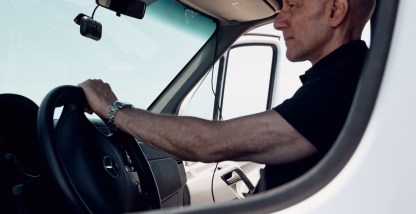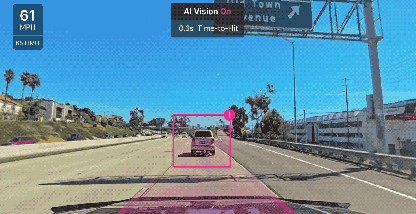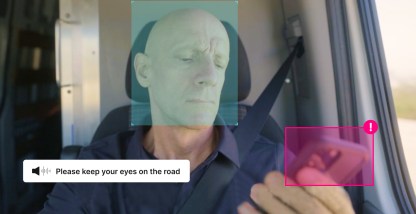A professional-grade fleet dashcam system provides many benefits:
- Serving as an objective witness via video footage
- Advising you a driver needs training or coaching
- Integrating with your ELD system
Additionally, installing a fleet video monitoring system integrated with your fleet’s ELD solution gives you the ability to remotely access the stored video.
What is a dashcam?
Dashcams are also known as dashboard cameras, fleet dashcams, or car dashcams. These are video cameras attached to the interior of the vehicle, often on the dashboard or rearview mirror.
There are front and rear dashcams, as well as side-mount, interior, and exterior cameras. Dash cameras can be battery-operated, powered by the vehicle’s electrical system, or solar-powered.
The best fleet dashcam benefits
Since commercial vehicles are exposed to more extremes than non-commercial automobiles, dashcams must be robust. They should be able to record continuously for hours on end, handle jolts and bumps and continue functioning during temperature fluctuations.
Many pro-grade dashcams include GPS data embedded in the video footage and HD video. They may also include Wide Dynamic Range (WDR) technology that can help you capture quality videos and high-level detail, such as license plate numbers, in both light and dark situations.
Here are three top features to look for when you consider professional-grade dashcams for your fleet.
1. Dual-facing
Dual-facing fleet dashcams record the road and the interior of the cab. Motive’s Smart Dashcam streamlines coaching, helps protect drivers, and will intelligently provide drivers with safety alerts.
2. Integration with your fleet management software
Integrating your dashcam with a Motive Asset Gateway allows your fleet manager to pull asset reports and view where equipment is at all times.
3. Critical event detection
When a fleet dashcam with a built-in accelerometer, aka G-sensor, detects unusually strong jolts, hard braking, acceleration, or impact from a collision, it will switch to event mode and record footage in a protected section of memory for later retrieval.
Depending on the brand of dashcam, recording typically begins 10 seconds before an incident, until about a minute after.
Meal service company exonerates driver with Motive’s Smart Dashcam footage
The benefit of a fleet dascam with G-sensor technology is the ability to automatically record crucial footage without intervention from the driver. Ask the owner of Nybll, a California-based food service provider.
A Nybll driver was involved in a collision when a motorcycle hit the rear of his vehicle. The driver had the Motive Smart Dashcam installed. Video proof from the dashcam ultimately showed that Nybll’s driver wasn’t at fault. He was not cited, and the company was saved from having to potentially pay out a large settlement, including personal injury.
The cost of collisions
Per the Federal Motor Carrier Safety Administration (FMCSA):
- The average cost of a fatal collision is $3,600,000.
- An injury collision costs nearly $200,000.
- The overall average cost of collisions is $91,000 per incident.
Cost reduction
Injuries, workers’ compensation, attorneys’ fees, and repairs cost time and money. With a reliable fleet dashcam, managers can review recorded videos and provide personalized, one-on-one coaching to drivers, improving safety and reducing unnecessary litigation and costs.
Exonerating a driver with video proof
“Footage from Motive’s Smart Dashcam exonerated our driver on the spot and saved us what could have been close to $50K in damages,” says crude oil transporter D&A McRae’s terminal manager Ron Conrad.
His driver had to make a quick lane change when another truck cut him off. Unfortunately, the back of his trailer clipped a passenger vehicle. No one was hurt, but a citation and repairs could have cost several thousand dollars and hurt the driver’s CSA score.
Management was able to remotely download relevant video from its dashcam and email it to the patrol officer, who made it a part of the official report. As a result, the D&A McRae driver was not cited.
Investing in fleet dashcams
Is it time for your company to invest in a dashcam system? As the above example shows, the return on your investment in dashcam technology can be quite high.
In a more serious accident, when the driver is exonerated by dashcam footage, the real savings can be in the hundreds of thousands of dollars or more. Also, fleets and drivers will enjoy using cutting-edge technology in the truck — GPS, telematics, and fleet management solutions.
What’s the cost of not investing in fleet dashcam technology?
Consider the cost savings from avoiding one fraudulent claim or the lost revenue from even one collision. Having this technology in place before you need it can save you far more than the cost of the system.
Increase safety with fleet dashcams
Hopefully, you’ll never know how much a serious accident can cost the carrier. The benefits of having a fleet dashcam system far outweigh the risks of going without one.
Your dashcam can help you keep your drivers safe, provide training and coaching opportunities on an ongoing basis, and serve as an objective witness to what really happens when your vehicle is on the road. Learn more by reading our ultimate guide to dashcams.









